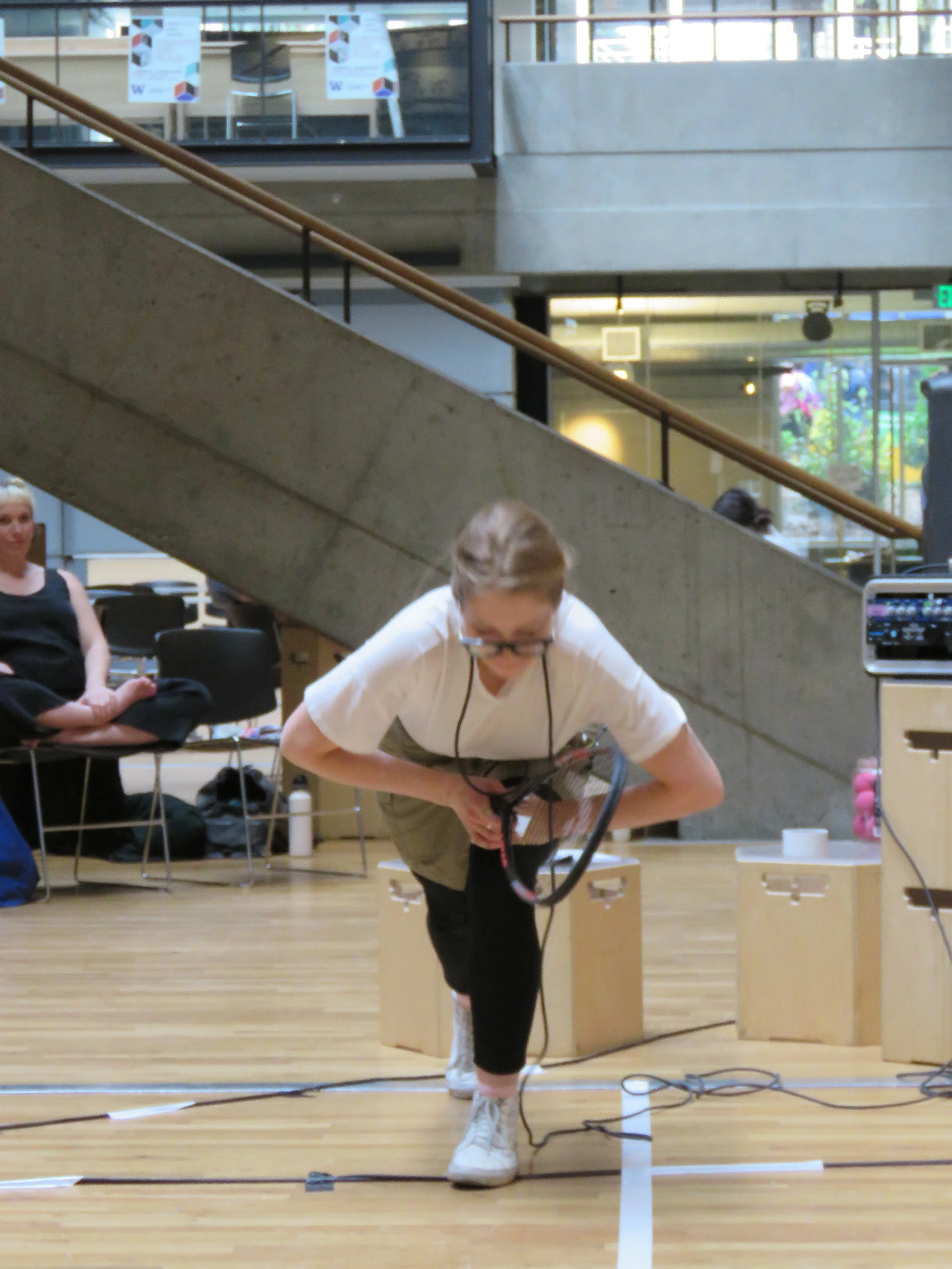Racquetball Score Sound Performance
This past winter, I created a sound performance titled Racquetball Score, which explores gender non-binary-ness through soundscapes strategically sourced through a game of racquetball using live feedback and embedded piezo mics.
Click here to visit sound recordings of the performance.
Performance development; 2019
Performing at On the Boards’ Performance Lab on April 24, 2019
Performances
April 4, 2019 // Design Trouble Symposium, University of Washington
April 24, 2019 // On the Boards Performance Lab, Seattle, WA
Project Description:
The idea for this performance came from my own personal practice of playing solo games of racquetball at the University of Washington’s gym as a way to decompress. As I was pondering the intersections of sound and gender, I thought it would be funny to source a type of ‘white noise’ from the inseam of my shorts rubbing together as I ran around playing racquetball. I also realized other things could be used to generate sounds such as the walls and rackets. Racquetball courts are also already acoustically rich places full of the echo-y smacking of balls, squeaking of sneakers, the thudding of footsteps and laughter or shouts of people playing nearby.
As I began to develop the piece, the performance took shape as a confluence of symbols of gender built into the infrastructures of a kinetic sound system which then became a space to be shaped by, and act and perform within. In this way, the performance was the animation of a self-built system, exploring the possible narrative arcs or sculptural and sonic potentialities in this new system-space. This to me is an extension John Cage’s experimental 'open works’ where, “musical arguments are replaced by processes that result in “music,” and the writing of music is supplanted by the creation of situations” (LaBelle, 2015).
Initial Sketch of the concept and the space at University of Washington’s Gould Hall where I performed it on April 4, 2019 as a part of the Design Trouble Symposium
I created three unique symbol sounds, a pair of shorts, a racket and the lines of the racquetball court. The shorts had a piezo mic embedded in the crotch, making a kind of white noise from the friction of my legs brushing against each other during play. Another sound-generating part of the system was the racket, which had a piezo mic secured to its strings. The amplification of the racket also references the performance piece, Open Score, created by Robert Rauschenberg, which was an electronic sound performance that utilized sounds from a game of tennis and was a part of a Bell Electric arts and engineering collaboration in 1966 titled 9 Evenings: Theatre & Engineering held at the 69th Regiment Armory, New York. The final sound gesture was the generation of a court. I did this by placing a piezo mic under tape as I pulled lines of tape out to create the service boundaries normally found in a racquetball court space. These lines became a symbol of building the grounds on which to play a game, (a game without many rules or without competitive play at least) a new space for gendered identities to belong or behave.
The infrastructure the performance utilizes, or the physical microphones, electronics, mixer, speakers and pedal also became to be interesting to me. I felt that ultimately, while this project was about creating this system, performing within the system was about the slow, dogged, management and manipulation of complexity in order to generate desired effects.
Below I share photos of my process of building, testing, rehearsing and annotating. I also share photos of two different performances and a short video of clips from one performance. Also, check out my Soundcloud where the performance and preliminary sound explorations are archived.
Process
I built the sounds system from piezo elements soldered onto microphone cable, created a pre-amplifier, and prototyped a design for the shorts using muslin and a pattern copied from a favorite pair of shorts. I created a high-fidelity version of the shorts using the pre-amp, cargo shorts, a piezo sewed into the crotch attached to the mixer via bluetooth. I moved on exploring the capabilities of the sound system, distortion pedals, scoring the performance through templates I designed myself and playing with movement that would activate the sound system. Final pictures are from performances I gave at Design Trouble Symposium and On the Boards’ Performance Lab.














